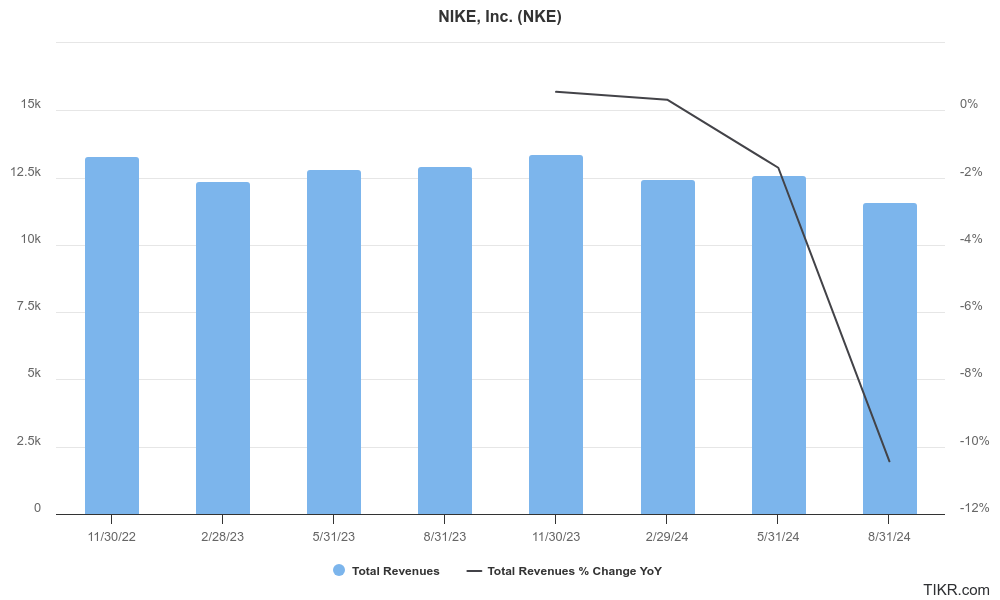Nike Stock Crashed After Fiscal Q1 Earnings Release: Key Takeaways
Please note that we are not authorised to provide any investment advice. The content on this page is for information purposes only.
Nike stock (NYSE: NKE) fell 6.7% yesterday as markets gave a thumbs down to its fiscal Q1 2025 earnings. Here are the key takeaways from the report and how analysts reacted to the sneaker giant’s earnings.
Nike reported revenues of $11.59 billion in the fiscal first quarter which were 10% lower YoY and below the $11.65 billion that analysts were modeling. The company’s per-share earnings however came in at 70 cents which was ahead of the 52 cents that analysts were expecting.
Nike’s guidance for the current quarter was also below Street estimates. The company forecast sales to fall by between 8%-10% in the current quarter which is worse than the 6.9% fall that analysts were expecting.
Notably, while Nike’s bottomline performance has been relatively strong, its topline growth has disappointed and it missed revenue estimates in three of the four quarters in the last fiscal year also.
Table of Contents
Nike Withdrew Its Annual Guidance
Nike withdrew its annual guidance and intends to provide quarterly guidance during this fiscal year. “This provides Elliot with the flexibility to reconnect with our employees and teams, evaluate the current strategies and business trends, and develop our plans to best position the business for fiscal ’26 and beyond,” finance chief Matthew Friend said on an earnings call with analysts,” said Nike’s CEO Matthew Friend on the decision.
The company also postponed its investor day was scheduled for the next month.
Nike Replaced Its CEO
Earlier this month, Nike announced that Elliott Hill would replace John Donahoe as the company’s CEO effective October 14, 2024.
Hill worked at Nike for 32 years before retiring in 2020. Donahoe took over as the CEO in January 2020 and led the company during the COVID-19 pandemic. While Nike stock rose to an all-time high in late 2021 under his watch, the stock now trades below the price levels when he took over.
Notably, Donahoe revamped Nike’s sales and distribution strategy to focus on the Direct channel – which includes both its stores and online sales through its website. In the process, the company cut down on wholesalers which are an important distribution channel.
The strategy paid off well during the COVID-19 pandemic when many people pivoted to ecommerce and Nike’s online sales soared. However, by cutting back on wholesalers, Nike opened the gate for competition to occupy its shelf space. While direct sales are invariably high margin as compared to channel sales, the strategy backfired as people returned back to stores – many of which did not either have Nike products or had limited stock.
How Analysts Reacted to NKE’s Earnings
Analysts had mixed reactions to Nike’s earnings. Jefferies analyst Randal Konik reiterated his hold rating on Nike and said that the company is “still not out of the woods.” Konik, who believes that Nike beat its earnings only because of the “low bar,” said, “There are a lot of changes that need to take place, while we await CEO-elect Hill’s strategic plans.” He added, “In the meantime, market share losses are likely to continue … and the consumer becomes more challenged.”
Truist analyst Joseph Civello also maintained his hold rating on Nike and said the visibility into Nike’s business “appears lower than we previously anticipated, which adds an incremental layer of difficulty to an already-tough task for incoming CEO Elliott Hill.”
JPMorgan analyst Matthew Boss also maintained his neutral rating on Nike and said it faces “an elongated timeline” to “re-accelerate revenue growth in the midst of a franchise product lifecycle transition.”
He added, “While we see continued annual gross margin expansion (strategic pricing benefits & lower product costs), [Nike] intends to continue to reinvest notably across demand creation to support new innovation as it scales in the marketplace & brand-building efforts.”
Some Analysts See a Buying Opportunity in Nike
Meanwhile, it is not all gloom and doom, and Deutsche Bank analyst Krisztina Katai maintained her buy rating on Nike while lowering the price target by $3 to $92. According to Katai, Nike is “getting back in shape … one step at a time.”
In her note, Katai said, “NKE’s 1Q print reinforced our view that the turnaround will be a marathon, not a sprint.”
She added, “This is why we are optimistic about incoming CEO Elliott Hill. He brings back much-needed institutional knowledge. … We expect a renewed focus on product, both in core and specialty running, and greater engagement with consumers as NKE rebuilds its wholesale relationships.
Bank of America’s Lorraine Hutchinson is also constructive on Nike and said that the company’s “next chapter begins with a clean slate.”
She added, “We think the fundamental reset ahead of Hill taking over as CEO later this note tempers the risk of a sales miss and gives Hill the flexibility to implement his strategy.”
Nike itself admits that the turnaround will take time. “NIKE’s first quarter results largely met our expectations. A comeback at this scale takes time, but we see early wins — from momentum in key sports to accelerating our pace of newness and innovation,” said Friend in his prepared remarks.
Nike shares are slightly lower in US premarket price action after the crash yesterday.






